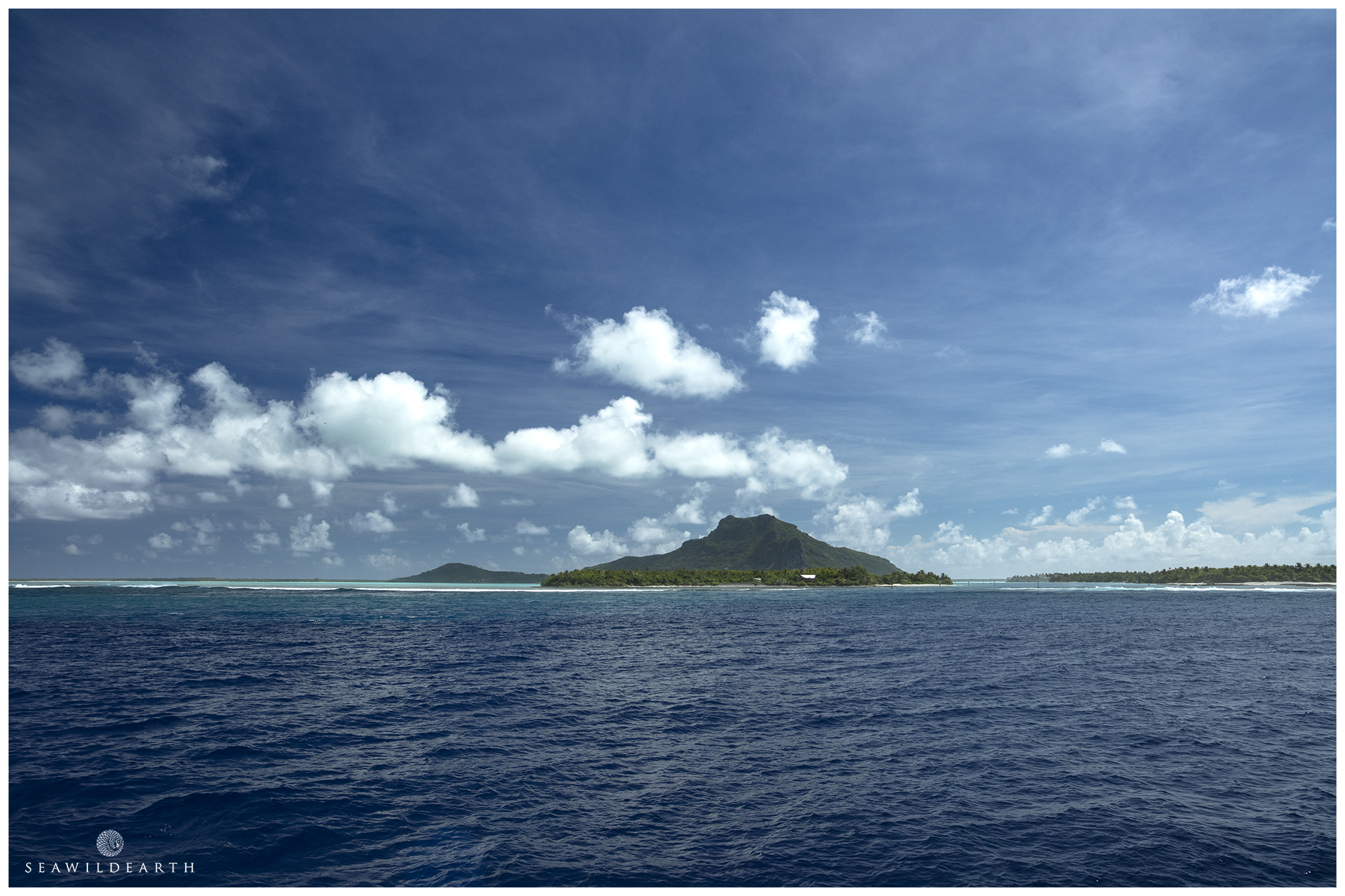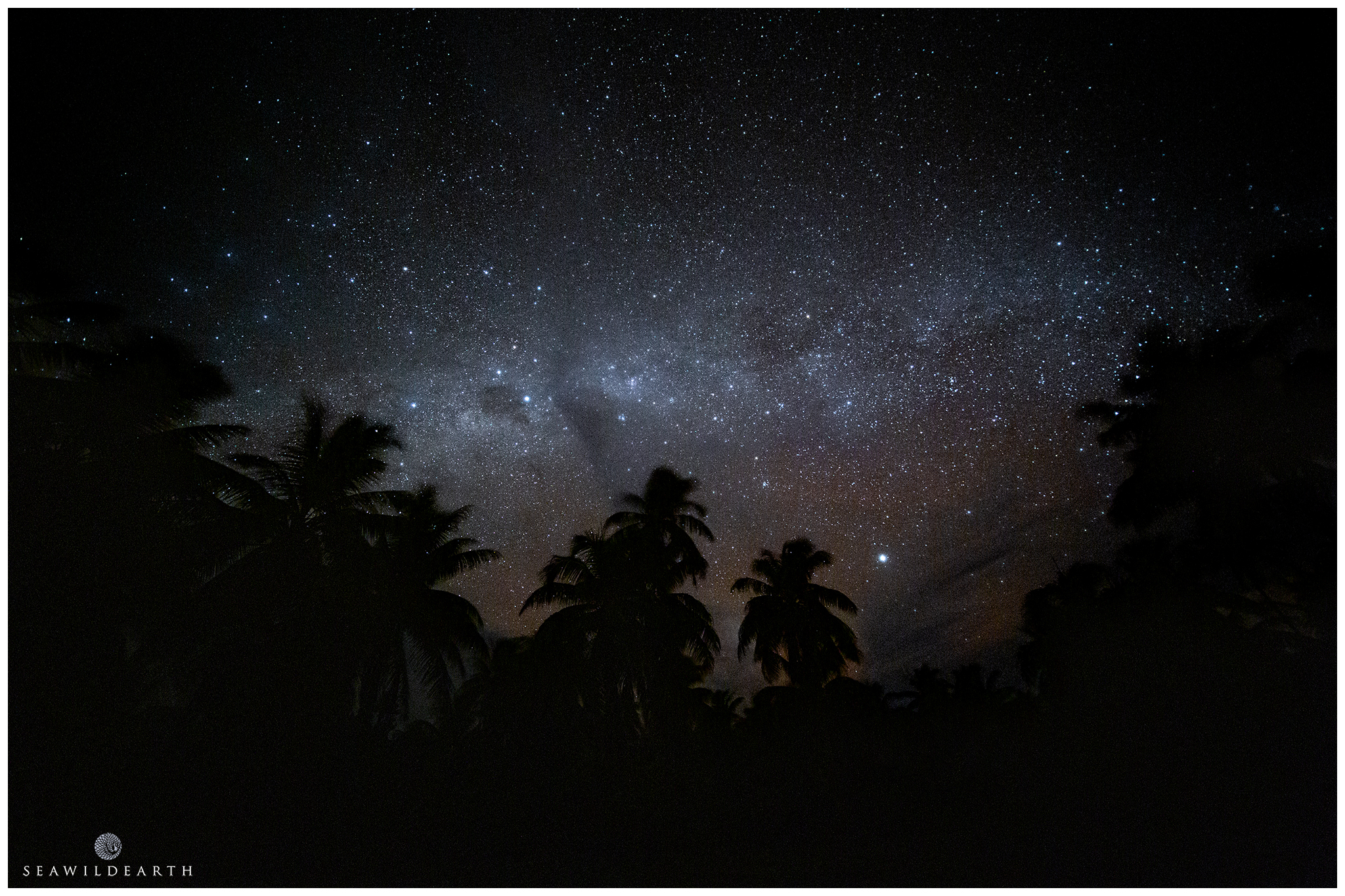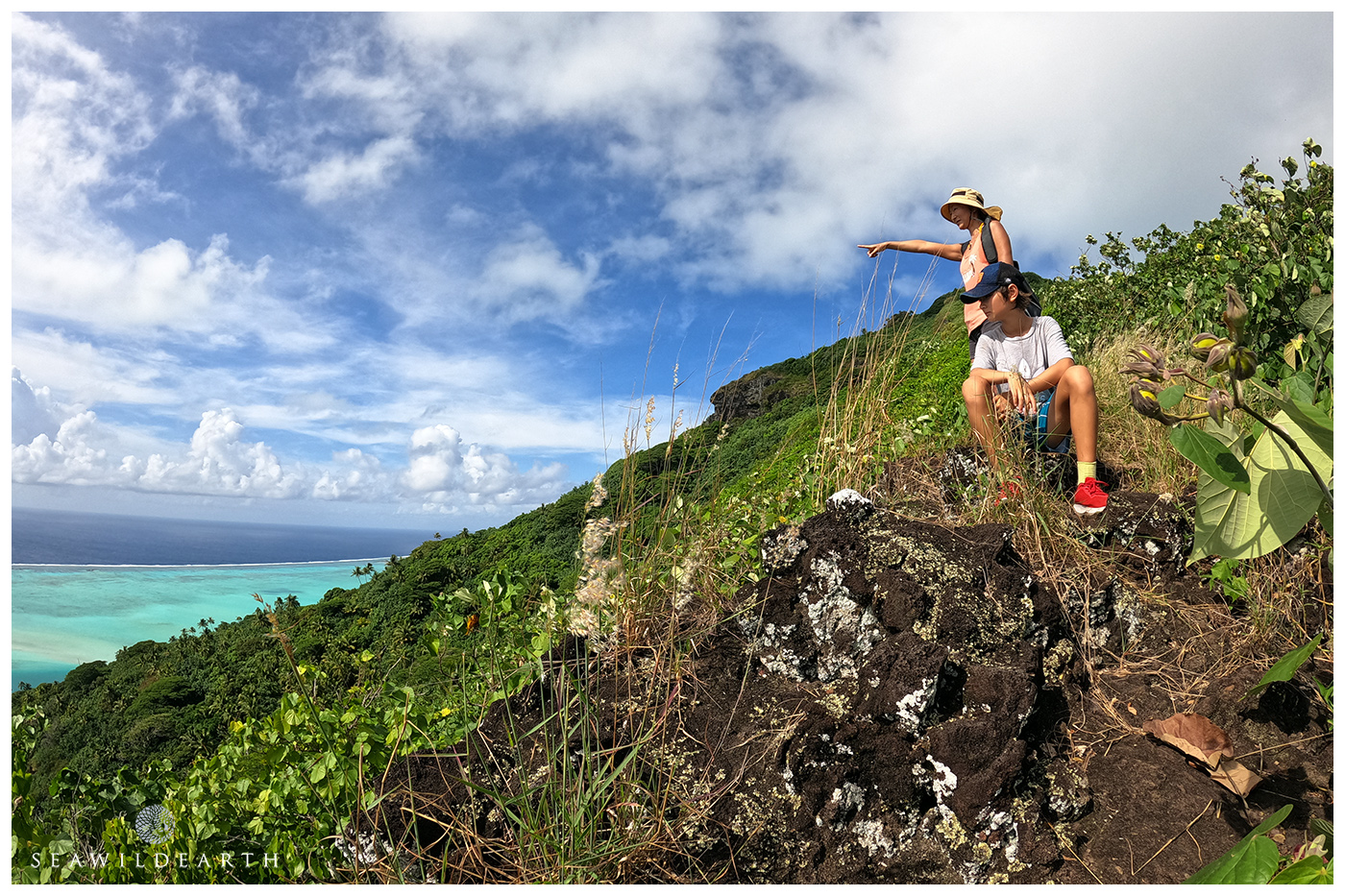Oui, Oui, Maupiti
The standout gem from our recent trip to Tahiti.
"Oui, Oui, Maupiti". This had become my trip slogan. After spending five days in Bora Bora the playground of the rich and famous, on a tight budget, we found ourselves slipping into the main channel of the little known neighboring island of Maupiti. Swapping the infamous skyline dominated by Mt. Otemanu in Bora Bora our ferry, the Maupiti Express 2, pulled into the main dock of the island in the shadow of he slightly less imposing 380m peak of Mt. Teurafaatiu. Having read numerous accounts of just how rough the Oceans can get in this part of the World I was stoked that our two and a half hour crossing from Bora Bora had been in relatively calm seas, calm enough not to bother our son Joshua who is prone to seasickness. As our ferry disgorged its human cargo, a melange of returning locals, backpackers and regular tourists we took stock of our location.
Maupiti is what Bora Bora was some 30yrs ago. No big brand hotels, no major resorts, no over water bungalows. The only thing taller than a coconut tree seemed to be the church spires evident on the main island. We were staying on one of the outer lying islands on the main reef, these islands, or Motu's, offer the chance to have the clear, warm, turquoise waters famous to this region lapping at the shores of the accommodation option one chooses. To this end we had booked a three night stay on Motu Tiapaa being hosted by Sem and his wife Vaii who own and run Pension Menoarii.
Meeting our hosts at the main dock we transferred all of our belongings into their small skiff and headed out towards the palm tree fringed, golden sand beaches of our chosen destination. As the colors of the waters transitioned from cobalt blue to turquoise to almost white we pulled into their small pier, met by a bouncing trio of fur balls who became our mascots of the trip. Once Josh found out they also had cats, with kittens, he was gone. Being the massive animal lover he is he was in heaven. My wife, Terri, and I had other plans. The water was just too inviting to pass up.
Slipping into liquid we were amazed at both the warmth and almost limitless underwater visibility. A word of warning on swimming in Maupiti. As picturesque as this location is the surrounding reef system has only one channel which means the water that enters the lagoon by way of the pounding waves on the outer reef has to exit by the main channel. As such there is a constantly outflowing current in the channel. The closer you get to the mouth of the channel the stronger that becomes. It can at times hinder ocean going craft entry into the main channel depending on the strength. This is something to bear in mind for anyone going there.
The remainder of our first day was spent pretty much enjoying the waters surrounding our Motu. While the terrestrial mass of the island is predominantly private property we had free reign to walk around the island via the beaches and sandbars that are present. It was tough to soak up the real beauty of the place. It's as if time stood still. Knowing what we know now the locals of Maupiti simply do not want their island to become another Bora Bora, which by some is considered as the 'sacrificed island' of the region. Branded hotels and resorts have tried over the years to get a foothold in Maupiti but all attempts have been rejected by the locals. Instead preferring the island to only offer pension and camping accommodation Maupiti enjoys that relaxed pace, that tranquility one so often goes in search of. Money, it seems, cannot buy everything.
If Maupiti is known for one thing its about the opportunity to swim with one of the Ocean's most iconic of all megafauna, Giant Manta Rays. These gentle giants can be found hovering over small coral and rocky outcrops in the main lagoon of the island. We signed up for an island tour that included stopping to swim with the Mantas for our second day. We were not disappointed.
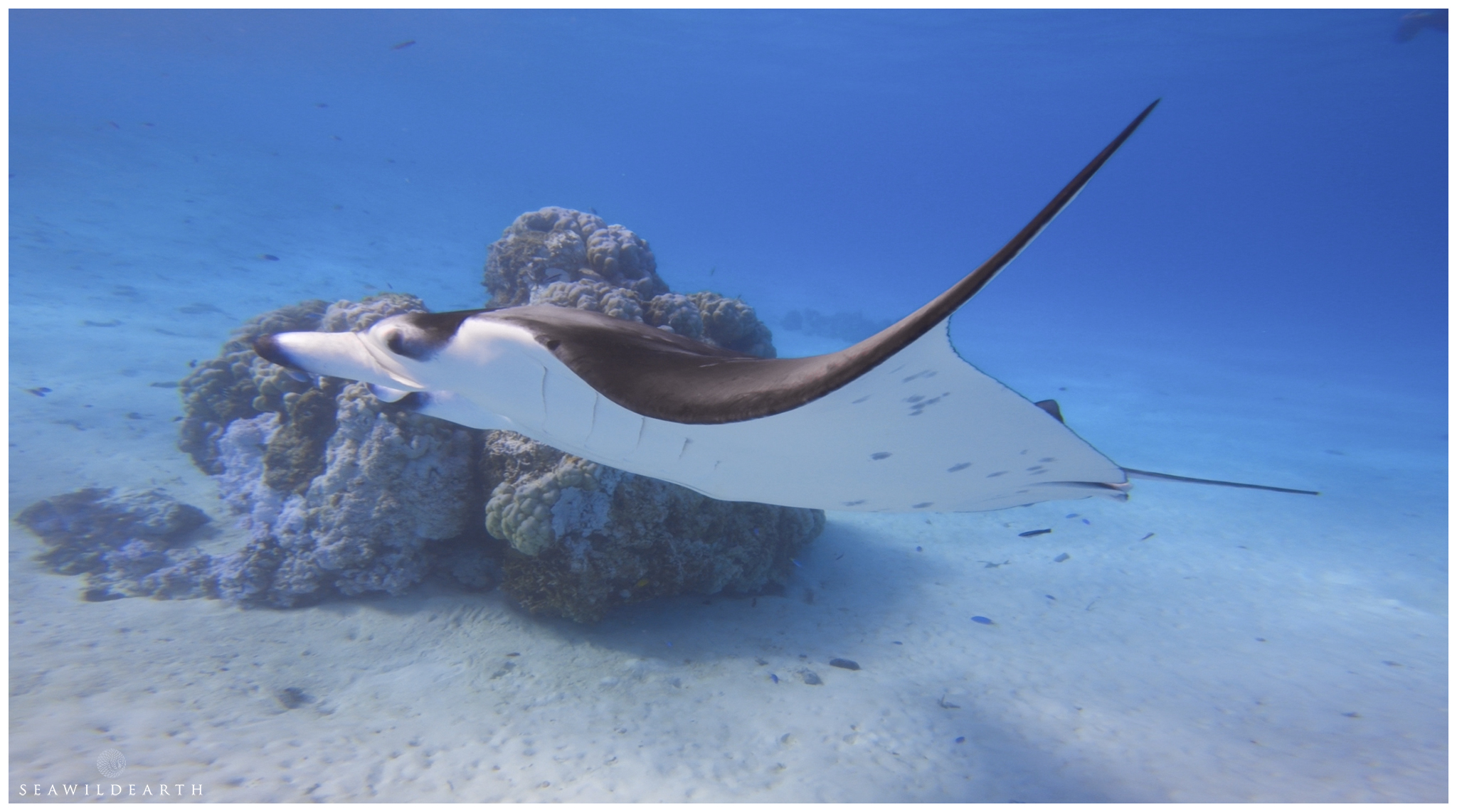
A GoPro Hero 9 video still taken of a close encounter with a Giant Manta Ray in the shallow lagoon of Maupiti.
In my adventurous past I had lived on a small Micronesian Island named Yap for a number of years. Yap is a firm fixture on the international dive map as a place famed for its Manta Ray population. While the interaction in Yap happened in deeper reef channels the action in Maupiti took place in mere meters of water. Not being the Worlds best freediver it was a relatively simple affair to duck dive down about 5m and lay on the sandy floor of the lagoon as a giant looming shape emerged from the blue and almost knighted me with its wingtip. Our son Josh was in raptures. While in Bora Bora we had also done the Shark and Stingray trip which, until that point, had been his highlight. Seeing the sheer size of the Manta Rays and also noting their gentle demeanor this soon became his favorite memory of the trip. "Oui, Oui, Maupiti".
We left the Mantas behind as the boats arriving to disgorge more swimmers into the area increased. The Mantas come in search of coral heads where small fish, known as cleaner fish, reside. Tending to be smaller fish from the Wrasse family they are tasked with picking of parasites and dead skin from all manner of marine life who visit their 'stations'. These spots known as cleaning stations in Maupiti are far enough away from the stronger currents of the main channel to allow swimmers of all abilities to enjoy interactions with these gentle giants.
Heading off to what Sem, our guide, called the Coral Gardens of Maupiti we could only prepare ourselves for what was to come. For this particular trip I had schlepped a massive dome port with which to shoot split water imagery from this part of the World. Just the clarity of the water lended itself perfectly to that style of photography. We spent the next few hours swimming in some of the cleanest and clearest waters either I, or my wife, had ever witnessed.
Swimming through clouds of colorful reef fishes and the occasional glimpse of a reef shark or stingray in the shallows the Coral Gardens of Maupiti are a sight unto themselves. Maybe not as prolific on the fish count as the famous Coral Gardens of the Island of Taha'a but prolific nonetheless. Josh by now had grown a set of gills and was fast becoming a mainstay of the Maupiti reef system. It took all we had to wrestle him from the water to continue our tour. We continued the experience with a trip to a small yet picturesque beach, I mean which beach in French Polynesia is not picturesque? Family photos and some relaxing were the order of this stop.
Our tour was rounded out with a quick trip to the main channel entrance of the island. Large barreling waves were pounding each shoulder of the main channel on that day. For a moment I had the horrible thought that maybe our boat was not strong enough to counter the massive outgoing current that we encountered. Alas, inch by inch the engine protested against the maelstrom to return us to the dock of Pension Menoarii, and the welcoming fanfare of the fur ball trio. Awaiting us was a spread fit for a king. Freshly caught Sashimi, the famous dish of the region, Poisson Cru, and some roast chicken for Josh, who even though we live in the Japanese islands of Okinawa, eats no seafood.
As per most days we spent the remainder of the daylight hours in or around the transparent shallows of the Motu. Other than the Manta Rays the island seem to be a haven for rays of all kinds. We encountered numerous stingrays and untold numbers of more skittish eagle rays. There was however one thing, well two in fact, that I wanted to try. During our stay thus far in these remote yet pristine islands I was amazed at the clarity of the night skies. Even though we were also in the southern hemisphere I also wanted to look at shooting the Milky Way. For this I had brought my super wide angle Laowa 12mm f2.8 lens which is also the mainstay lens for the split water photography. Our hosts also own a large tract of land behind the location of the pension so I had clearance to head into the palm tree grove in the nocturnal hours to shoot the skies, and how majestic they were.
Watching the skies from the deck over the water I could make out the Southern Cross and other constellations that I cannot see when shooting the Milky Way in Okinawa. This night was so clear it was amazing. Setting up my tripod I wanted to also include the silhouettes of the Palm Trees in the image so went deeper into the coconut grove for the shot. The one real danger here though is falling coconuts. It is a very real statistic that many people die each year from falling coconuts. Some of the trees in the grove were quite tall, some around 25m tall. With a good sized healthy coconut weighing in at around 3kg, can you imagine?
Shooting the stars from a couple of locations I was twice reminded of the necessity to be vary careful about placement when in such locations. The first thud I couldn't quite figure out what it was. Similar to the character in Castaway played by Tom Hanks I was left perplexed at what could have been a heavy footed intruder. Just a few minutes later, when making adjustments to the camera settings and composition, the periphery of my headlamp illuminated the landing of a skull crushing sized coconut along with its now familiar "Whump" as it collided with the sandy floor of the island.
I made a point of noticing all of the warning signs for falling coconuts on the island from that point on. I also made it a point for the family to also be very well aware of the danger. Avoiding coconuts, the following morning we had opted to do the one that that was screaming at us to do from the moment we first laid eyes on Maupiti, to climb the 'mountain' that dominated the skyline. As we are avid hillwalkers when at home, we'd decided, to the chagrin of wee Josh, to take the morning of our last full day on the island to scale Mt. Teurafaatiu. It was from this trek that my catchphrase "Oui, Oui, Maupiti" was borne. And I'm sure you'll agree, when you see it, that no other statement is fitting of that adventure.
For me the ideal, the perfect scenario unfolded in Maupiti. On our arrival in Tahiti we bought the Vodafone SIM card for my iPhone. This we needed for communication with all of the service providers we'd arranged accommodation and excursions with in the build up to our tour. It worked flawlessly in all locations, except Maupiti. For four glorious days. No internet, no calls, no emails, no depressing News headlines. It didn't take long to get into the rhythm of sleeping and waking with the rise and fall of the sun. Bliss. Very soon one realizes all of the 'comforts' we surround ourselves with, all the things we convince ourselves we cannot live without, they all become so very insignificant, so very unnecessary at the end of the day. This was living.
The mountain was calling. Unlike other destinations on our current itinerary this hill was accessible. So we set out. Most folks climbing this hill opt to take what we termed as the 'short route'. After Sem dropped us off at a dock on the main island we turned right on the main road, the only road, and set off. Stopping along the way to reserve a lunch spot at the popular Tarona eatery prior to setting for the heights of the island. We opted to pass up the 'short route' and instead wanted so walk the trail that took in the crest of the island. It took us a lot longer than planned. Initially the gentle incline became more severe, much to the distaste of Josh, but it also took in some pretty dramatic knife edge sections where we stood atop a 1m wide platform of rock that quickly dropped away on each side to reveal amazing vistas out across the lagoon. But the best was to come.
We spent the next 90 minutes sweating, profusely, farting and no doubt cussing the heat of the day as the mercury, mimicking us, climbed higher. Chugging down water as we climber higher and higher our rest breaks became more and more frequent, we were in no rush. The gentle breeze that would envelope us when we rested cooled down the sweat soaked clothing and in turn offered a nice respite from the heat. But we were almost there.
Voices grew louder in the undergrowth. The final stretch of the climb was under cover of vegetation so that gave us some nice shade. However what was missing was the vertical climbs we'd been told to expect, some with the aid of placed ropes. We'd not experienced nor come across such features. Passing a small radio antenna a clear opening in the vegetation gave way to a vista that can only be described as stunning. We found ourselves stepping out onto a small rocky clearing with enough space for about three people standing. And there before us, the lower heights, another vantage point and the foothills of the island gave way to the lagoon and shallows. In the distance we could easily make out our Motu home, the left of the two distant islands close to the main channel entrance. "Oui, Oui, Maupiti".
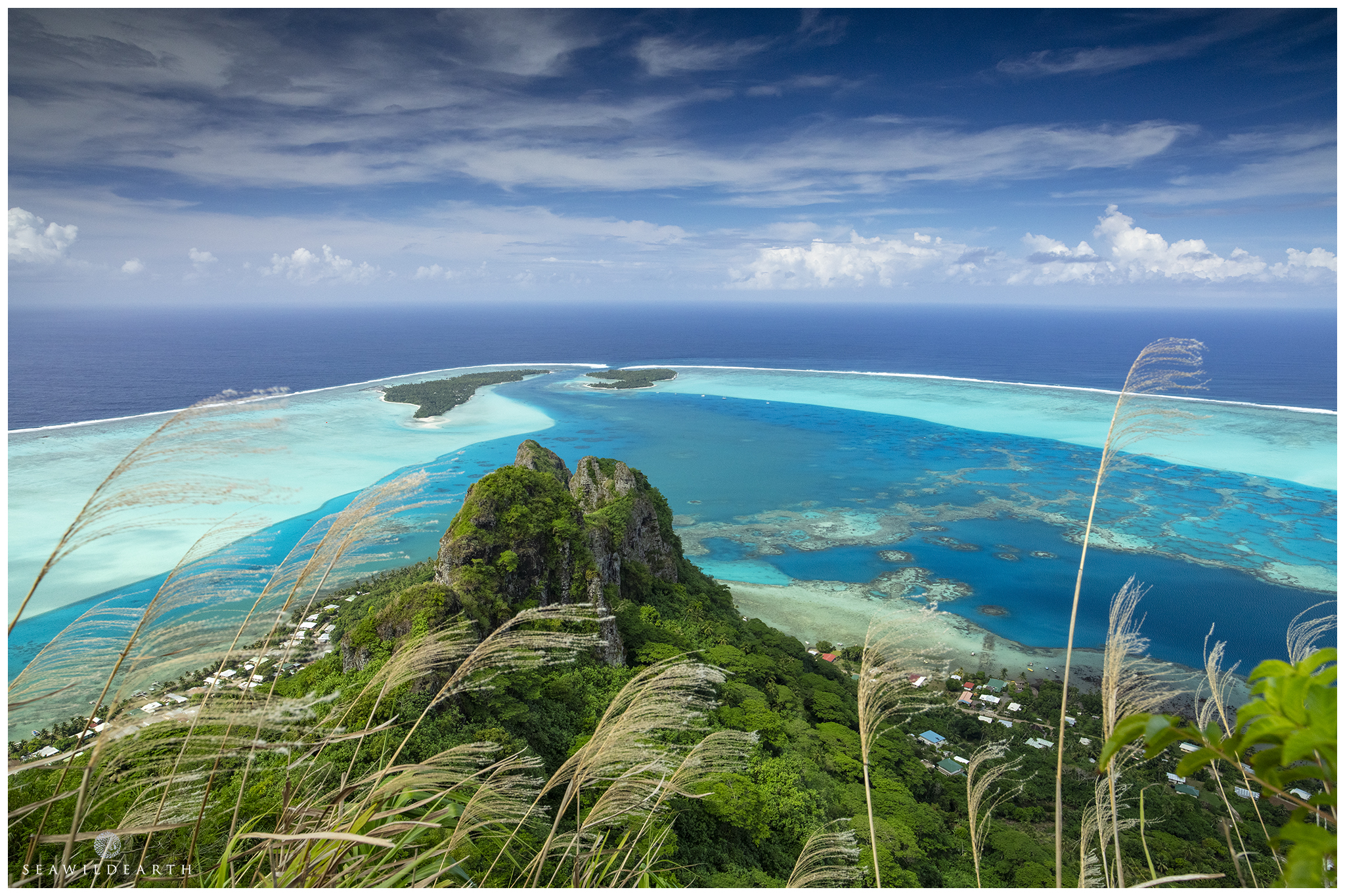
"Oui, Oui, Maupiti" and now you can see why the exclamation "Yes, Yes, Maupiti" was born. Such a stunning vista at the end of this short trek.
Once stopped atop the island the breeze soon dried out our clothing. Taking in the vista was just incredible, at times we fell silent, lost in our respective senses of appreciation of both the place and the family. It was with this vision burning into my memory that I coined that catchphrase, "Oui, Oui, Maupiti". This truly was a magical and golden family moment to cherish. Even Josh cracked a smile once at the final top spot, knowing the sweating was all done. Now just to make our way down.
Our descent took us along the path that most folks climb the hill by. In that trajectory we soon encountered those vertical spaces we were initially told about with ropes to aid walkers in their ascent/descent of the hill. Stopping at every given vista Terri was close to filling her iPhone memory with imagery from that adventure. Pretty soon we were back to ground level and making our way to the restaurant for lunch. If you've never been to French Polynesia you'll be amazed at the size of the portions. Tahitians are big people, and it's clear to see why. We could easily order just two meals for the three of us and still have contents for a take-out of the remaining fare.
All too soon our time in Maupiti was up. We spent the rest of that afternoon once again swimming in the shallow waters of the Motu. Hanging out with Stingrays, Giant Trevally, Eagle Rays and one curious little Octopus that Josh found under the jetty of a neighboring pension. It is now with great fondness we remember the warmth of our hosts, the comforting embrace of the lagoon waters and the majestic company of the gentle Manta Rays of Maupiti. Mix that with the new friendships made with other travelers staying at the pension, with a group of French travelers staying at another Pension on the Motu who we dutifully renamed the 'Josh Fanclub' (no doubt the focus of a future blog entry). Soon we found our attention turning to our packing up our gear and belongings as we made preparations for the next leg of our trip, the Coral Gardens of Taha'a.
To get a true understanding of what Terri and Josh thought of Maupiti, head to the top of this page and hit that circular icon with the opposing arrows that will appear on the top right corner. Click it again to return to this page.
*Notes;
I'm wrapping up this somewhat longer blog post. While I took lots of imagery from this trip I couldn't find place to put them all here. To that end I'd suggest following my Instagram as I update there a lot more often than I post blogs. I have also linked this blog to the Facebook oage of Pension Menoarii. That said please understand that they have very limited access to internet connections. While they may not be able to update their imaging based platforms that often they are very responsive when it comes to emails or messaging. Reach out to Vaii if you're planning to head that way. Retrace these steps and I'm sure that you too will be repeating my catchphrase; "Oui, Oui, Maupiti".
"Wherever you go, go with all your heart".
Confucius - Chinese Philosopher
About the Author
Internationally recognized as a provider of quality mixed media Mark Thorpe is always on the search for captivating content.

Photographer / Cameraman
Mark Thorpe
Emmy Award Winning wildlife cameraman and Internationally published landscape photographer Mark Thorpe has been an adventurer since he could walk! Spending 17yrs as an Underwater Cameraman at the start of his imaging career the highlight of which was being contracted to work with National Geographic. In that role as a field producer and cameraman he's been privy to a mixed bag of hair raising adventures. For some reason he was always selected for projects relating to large toothed marine predators such as Great White and Tiger Sharks, Sperm Whales and Fur Seals. Additionally he has also been active within Southern Africa on terrestrial projects dealing with a wide array of iconic wildlife.
Currently based in Okinawa, Japan he's always on the lookout for his next big adventure. He shares his exploits online with a totally organic social audience. Sponsored by a number of photographic industry manufacturers he is constantly scouring the islands for captivating landscape and 'Oceanscape' compositions. Videography wise he continues to create short form content to promote the diversity of wildlife within the Okinawa prefecture as well as a growing lean towards matters of conservation and responsible environmentalism.
With a comprehensive kit bag and a strong desire to promote responsible Ocean tourism Mark is available globally for commissions by resort entities looking for a dynamic and fresh revitalizing upgrade to their promotional media. Adept in Ocean related imaging, landscape, portrait and product photography along with his proven grounding in video applications he has been instrumental in the provision of promotional media for numerous travel and tourism related clients through the years. Having also been commissioned by discerning private sector clientele to document their private travel adventures this adds a further option for those looking for that truly unique imaging option for their travel experience of a lifetime.
Please feel free to reach out with your requests via the no-obligation contact form on this site.


